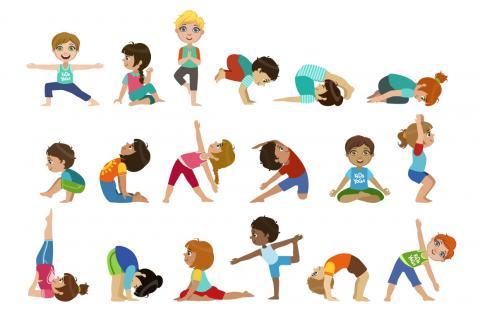
So how young a kid is too young for yoga? Well if your little one can follow basic instructions, and loves to groove with you, then you should start yesterday already!
Practicing yoga is awesome for anyone to become holistically and wholesomely fit. And with this, we mean physically fit, mentally calm, physiologically balanced, and spiritually rich. When it’s such a good thing for adults, why do we wait to teach our children this amazing life hack? Many experts agree that yoga practice should begin at the formative years—this helps them to grow into well-balanced and healthy adults, instead of trying to fix their health issues with yoga at a later stage.
How old should kids be before they learn yoga?
There are some yoga teachers and gurus who can actually teach kids younger than three years even—and there are Facebook videos and posts supporting this as well. But usually kids that young do not follow instructions, and getting them to sit still is a task in itself. Some other gurus believe that the magical age to teach kids yoga is when they become eight and there is a reason for that too…
In traditional India in the olden times of the gurukul and the Brahmin training, children would have their thread ceremony (upanayanam) when they turned eight. At this time, their yogic training would begin, as would their knowledge of mantras and rituals. Eight is when “childhood” ended, and children would be packed off to traditional gurukul for learning and education. With the Western schooling concept now followed in India, all this changed pretty fast and kids are usually put in preschool between the ages of three to five—so learning starts pretty fast.
According to medical science, eight is actually an important milestone for children because the number of air sacs in the lungs stabilize at age eight; after that, they merely grow in size but not in number. This is why after age eight, pranayama is introduced. Plus, many yoga experts do state that practicing yoga early on delays the onset of puberty by a couple of years so, in a way, yoga is great for letting children be children that bit longer. That said, schools in India are incorporating yoga from preschool on, so it’s good to let your kids try yoga while you do your practice. But you have to involve them in different ways as per their ages. Here go some tips and tricks!
Getting Kids To Do Yoga: Ages 4 To 8
Kids this age are full of infinite energy (I’d know, I have two of them!), so yoga for them has to be energetic enough to wear them out for a last bout of relaxation…Here are some tips:
- Weave a yoga story with the poses involved. For instance, a child went to a farm, and this is what he saw. He saw a tree sway in the wind and a cow eating grass. He saw a cat stretch in the sun and a dog chase an eagle away. You get the picture, right – begin with the child pose, and move to the cow pose and the cat pose. Then comes the downward dog pose and the eagle pose. The idea is to do a sequence of 5-6 asanas along with a story narrative to make things interesting. The link here has some amazing yoga poses for kids…
- Always remember to ensure the kid’s attention is on you—else they will not hear any instructions, let alone follow them. Modulate your voice from a secretive whisper to an energetic drumroll and everything in between to catch and hold their attention.
- Alternate yoga poses with energetic exercises. Move from a cobra pose to 10 jumping jacks, and from a warrior pose to jogging on the spot. Slow-moving yoga isn’t for kids so don’t be hesitant to mix and match some exercise with yoga.
- Have a theme-based class for them—one day it could be animals, another day nature, and still another day plants and trees. You can use simple, light-weight props or dress up as you like for a really fun hour of yoga.
- Always end with relaxation and never try and “correct” kids too much. The grace of yoga takes a while in coming—kids this age are usually jerky in motor movements so do not try to put them down for stumbles and imbalances. Be encouraging and ask them to go higher, louder, tighter, and do one more and then another.
Shaping The Yoga Into Something Deeper: Ages 8 to 12
So we’ve reached the magic age of eight—and this is where things can get a little more serious with yoga poses, but still the fun-but-not-childish zone. Between the ages of eight to twelve, before puberty hits, children develop enhanced motor skills and are also more aware of their bodies.
- You can start extended and advanced poses with them now for children this age have great flexibility and a burgeoning strength. They may not yet possess the grace of an adult, but they can amaze you with their dedication. This is the time you can start using yoga props as well and even do some balancing exercises as games with them.
- Let the fun be there but take the childishness out of it. You can still have theme-based classes, but let the themes be more about upside-down poses, or strength, or bends, or even the face. Face yoga can be one hilarious class if you come to think about it! There can be weird-yoga themes as well if your class is acrobatic enough!
- This is the ideal time to introduce breathing exercises and pranayama to the kids as now they will have the patience to sit still and actually follow instructions. Pranayama will not only center them but also develop their lungs better and make then stronger individuals as adults.
- Weave in some yoga dance, or theatres, where children can perform a little skit, or do their favorite yoga pose as a performance for the rest of the group.
- Again, don’t be afraid to add in some extra activities to further raise the energy of the class—partner poses work really well for kids this age too. This also teaches them the importance of co-operation and teamwork—plus, it makes for plenty laughs. Also, remember never to compare one child’s skill level with another—there’s not much wrong you can do with yoga as long as there is no negativity.
Teaching yoga to kids can be a learning experience for you as well, and you don’t have to be formally educated for that. As long as you don’t push the children too much and have been a yoga disciple for years, imparting that knowledge is akin to spreading some love. Namaste!








